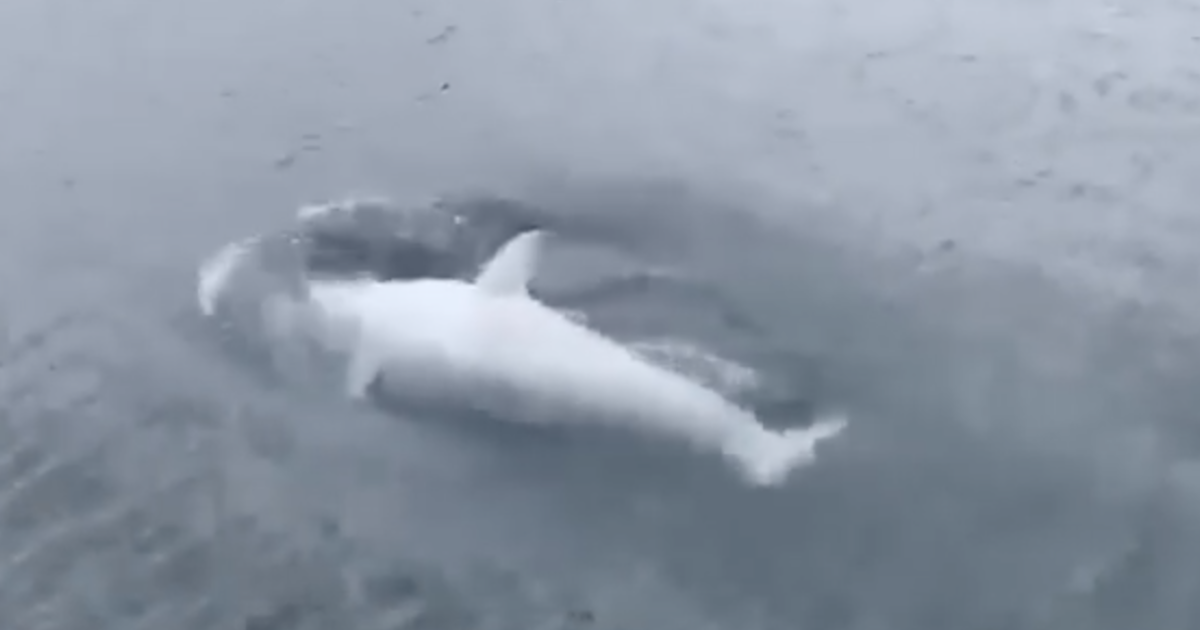A rare white killer whale has been spotted off the coast of Southeast Alaska. Researchers on an 80-foot charter boat spotted a pod of killer whales about a quarter mile away on August 7 – and one was glowing, Ned Rozell, a science writer for the University of Alaska Fairbanks’ Geophysical Institute, said in a press release.
Stephanie Hayes, a University of Alaska Fairbanks graduate student who was the first mate on the boat this summer, said they knew they were witnessing something special. “There was a collective gasp from everybody on the bow,” Hayes said in the release.
Killer whales, or orcas, are usually black and white. But in this family of three or four, there was one solid white whale, which is very rare.
“There have only been about eight white killer whales ever recorded in the world,” said Hayes, who studied killer whales during her undergraduate work in British Columbia. “To have one in Southeast was an incredible phenomenon.”
The rare white killer whale has a condition called leucism, Hayes said. The condition is a “lack of vibrancy” in pigmentation, caused by a mutation in the whale’s DNA. Leucism is different from albinism, in which a creature is all white, with pink eyes, according to the press release.
TI’uk in action last week off Alaska’s Cape Bendel! This rare white killer whale, whose name in Salish means moon, is charming us with his presence as he explores our pristine coves and waters! Thank you to @worldtravelstephanie for this video shot from our beloved Northern Song! #orca #whale #killerwhales #travelaska #wildlifephotography #wildlifevideos #travelgram #alaska #whalesofalaska #photooftheday📷 #natgeoyourshots #nationalgeographic #travelgram #livetravelchannel
Posted by Alaska Sea Adventures on Wednesday, August 12, 2020
Hayes said some have speculated leucism is caused by inbreeding, although scientists aren’t sure.
Hayes, who now studies squid as a grad student at UAF, said she feels lucky the COVID-19 pandemic interrupted her squid fieldwork this summer, according to the release.
“Not just to be able to see it, but to be able to see it hunting with the pod, was beyond what I could have ever hoped for as a scientist,” she said. “Hopefully, we can monitor it and find out what happens in the life of a white killer whale.”
Captain Rogers, who operated the ship and often hosts researchers on his vessel, said it was the first white killer whale he has seen in 45-plus years of sailing on Southeast waters. And it wasn’t the last time he saw the phenomenal whale.
Rogers – who posted videos of the whale on the Facebook page for his boating company, Alaska Sea Adventures – got a second glimpse of the whale outside of his window, which overlooks the ocean in Petersburg, Alaska. He spotted a pod of killer whales a few days later and, through his binoculars, saw the white one among them.
He called Hayes, who went searching for the whales and spotted them again from shore. Rogers also posted a photo.
Hayes was able to capture of the white whale swimming beside a black and white one.
Hayes and Rogers found that the white whale had been spotted before. It was documented by British Columbia researchers and named Tl’uk — a word for moon in the language of the Salish peoples of the Pacific Northwest, according to the press release.
Tl’uk is a two-year-old male killer whale. Whales are forced to leave their families when their mother rejects full-grown calves. When this happens to Tl’uk, he might be at a disadvantage due to its glowing appearance.
“A new pod might not accept it after it reaches sexual maturity,” Hayes said. Tl’uk’s color might also alert seals of his approach.
CBS News has reached out to Hayes and Rozell for more information and is awaiting response.
